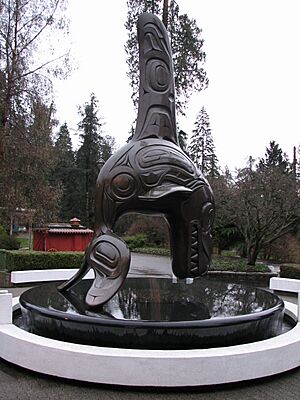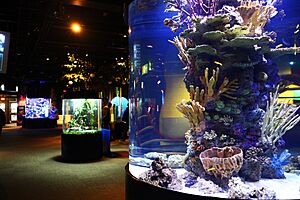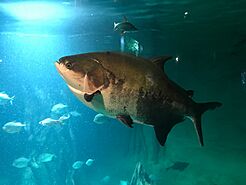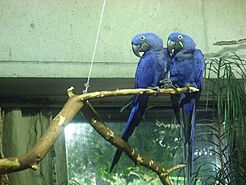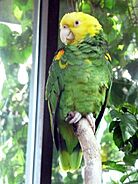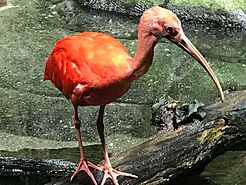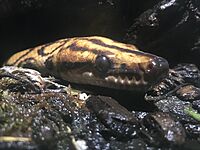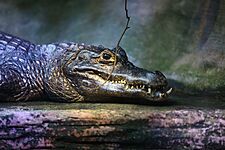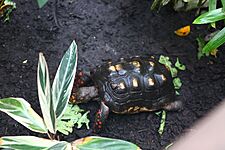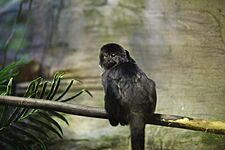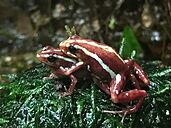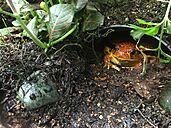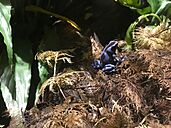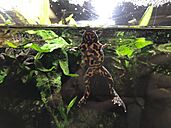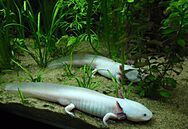Vancouver Aquarium facts for kids
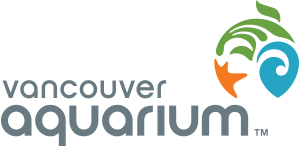 |
|
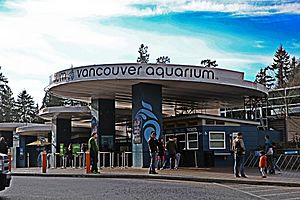
The Vancouver Aquarium in 2013
|
|
| Date opened | June 15, 1956 |
|---|---|
| Location | 845 Avison Way Vancouver, British Columbia V6G 3E2 |
| Land area | 2.1 acres (0.85 ha) |
| Coordinates | 49°18′02″N 123°07′52″W / 49.300586°N 123.131053°W |
| No. of animals | 65,000 |
| Total volume of tanks | 9,500,000 litres (2,100,000 imp gal; 2,500,000 US gal) |
| Memberships | AZA, CAZA, WAZA, AMMPA |
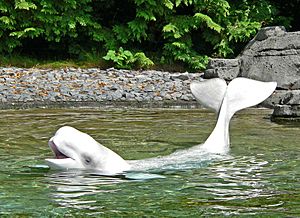
The Vancouver Aquarium is a famous public aquarium located in Stanley Park in Vancouver, British Columbia, Canada. It's a popular place for visitors and also a very important center. The aquarium focuses on marine research, teaching people about the ocean, and working to protect our planet from climate change. They also help rescue and care for marine animals.
The Vancouver Aquarium was one of the first places to have expert naturalists working in its exhibits. These naturalists helped visitors understand animal behaviors. Before this, some zoos had special events, but the Vancouver Aquarium was the first to hire educational naturalists full-time. Their research projects help animals all over the world, including rescuing and rehabilitating marine mammals.
In 2010, the Canadian Prime Minister Stephen Harper and B.C. Premier Gordon Campbell announced funding for the aquarium. The province gave $10 million, and the federal government added up to $5 million for upgrades. The aquarium remained a nonprofit organization at that time. The City of Vancouver owns the land and rents it to the aquarium.
In October 2009, the Vancouver Aquarium was recognized as a Coastal America Learning Center by the US Environmental Protection Agency. This was the first time a Canadian center received this honor. It helped strengthen the partnership between Canada and the US to protect shared ocean resources.
On August 31, 2020, the aquarium announced it would temporarily close its public programs. This was due to financial challenges from the COVID-19 pandemic. They continued to care for their animals while planning for the future. On April 15, 2021, the aquarium announced that Herschend Family Entertainment took over its ownership. The aquarium reopened to the public on August 16, 2021.
Contents
Discovering the Aquarium's History
The idea for the Vancouver Aquarium started in 1950 with professors from the University of British Columbia. With help from important people and funding from different levels of government, the aquarium opened its doors on June 15, 1956. It was officially Canada's first public aquarium.
Over the years, the Vancouver Aquarium grew to become the largest in Canada. It also became one of the biggest in North America. It was the second aquarium in the world to care for and display an orca. Other marine mammals like belugas and dolphins were also part of its history.
In 1975, the Vancouver Aquarium was the first aquarium to be recognized by the Association of Zoos and Aquariums (AZA). It is also recognized by the Canadian Association of Zoos and Aquariums (CAZA). In 1987, the Canadian government named it Canada's Pacific National Aquarium.
A beluga whale named Qila was born at the aquarium on July 23, 1995. She was the first beluga conceived and born in a Canadian aquarium. Another calf, Tuvaq, was born in 2002 but passed away unexpectedly in 2005.
In 1996, a local rule was made that stopped the Vancouver Aquarium from capturing cetaceans (whales and dolphins) from the wild for display. They could only get cetaceans from other facilities if they were born in captivity, rescued, or captured before 1996.
On June 15, 2006, Canada Post released a special stamp to celebrate the aquarium's 50th anniversary.
For many years, visitors loved the orca shows. The aquarium was home to several orcas over time. When the last orca, Bjossa, was left without companions, she was moved to another facility where she later passed away. Since then, the aquarium has focused more on teaching visitors about marine life and its important research and rescue efforts.
The aquarium has played a big role in studying wild orcas in British Columbia. Researchers like John Ford, who studies orca sounds, worked there for many years. The Wild Killer Whale Adoption Program, which helps fund research, also started at the aquarium.
Temporary Closure and New Ownership
On August 31, 2020, the aquarium announced a temporary pause in its public programs. Even though many people visited after reopening, social distancing rules meant fewer visitors. Ticket sales dropped significantly, and the non-profit organization couldn't cover its costs. They continued to provide excellent care for all the animals.
On April 15, 2021, the aquarium announced a new agreement. Ownership was transferred from the Ocean Wise Conservation Association to Herschend Family Entertainment. The aquarium reopened its doors to the public on August 16, 2021.
Exploring the Aquarium Facility
The Vancouver Aquarium covers about 9,000 square meters and holds 9.5 million liters of water in 166 different displays. It has many exciting galleries, some of which were built at different times.
Pacific Canada Pavilion
This main indoor exhibit features a large 260,000-liter tank right by the entrance. Here, you can see fish and invertebrates that live in the Strait of Georgia.
Steller's Bay and Canada's Arctic
This gallery once housed beluga whales. In October 2009, a new exhibit opened here, showing other arctic species like fish and invertebrates. In 2016, two rescued harbour porpoises moved into this area. After the belugas passed away in 2016, this area became an active research station called Steller's Bay. It works with the University of British Columbia to study Steller sea lions. The exhibit reopened as Steller's Bay on July 1, 2017, and still includes the Canada's Arctic section. It is home to six Steller sea lions. A "Research Outpost" exhibit opened in June 2018, offering programs about the aquarium's work with walruses, northern fur seals, and Steller sea lions.
Penguin Point
This exhibit was inspired by Boulders Beach and featured African penguins. Penguin Point was taken down in June 2023 to make space for a new habitat. The penguins moved to the West Edmonton Mall in 2023.
The Wild Coast
This outdoor area has several pools. It includes the Marine Mammal Rescue exhibit, where different pinniped species like harbour seals, Steller's sea lions, and a California sea lion are rotated for display. Sea otters also live here permanently. There's also a "surge pool" where visitors can touch British Columbian invertebrates.
Treasures of the B.C. Coast
This gallery has several exhibits that show the different aquatic environments along the BC coast. You can see a giant pacific octopus, rockfish, sea stars, sea urchins, and anemones. In 2021, the Vancouver Aquarium opened the Marine Rescue Exhibit, where visitors can meet ambassador animals from the Marine Mammal Rescue Centre.
Tropics Gallery
This gallery displays many tropical fish and other animals, including blacktip reef sharks. The green sea turtle named Schoona lived here until January 2023, when she moved to Ripley's Aquarium in Toronto, Canada.
Amazon Rainforest
This gallery is home to freshwater fish, snakes, caimans, sloths, birds, and other creatures from the Amazon.
Frogs Forever? Gallery
This exhibit focuses on the challenges facing the world's frog population. It teaches visitors how they can help protect frogs and other amphibians. It features 26 species of amphibians from around the world.
Canaccord Exploration Gallery
This gallery is home to jellies, fish, and other animals. It also has a 4D Theatre and a children's play area called "Clownfish Cove." Multiple classrooms for school groups are here, including a wet lab education room with computers, tables, and live animals.
Interpreters
The Vancouver Aquarium was the first aquarium to have a full-time team of paid interpreters. This program started in 1967. These interpreters give daily talks about animals like sea lions, seals, sea otters, jellyfish, and many fish species.
Amazing Animals at the Aquarium
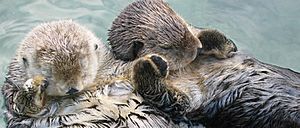
The Vancouver Aquarium currently cares for about 300 species of fish, nearly 30,000 invertebrates, and 56 species of amphibians and reptiles. They also have around 60 mammals and birds.
The aquarium no longer houses cetaceans (whales and dolphins). Here are some of the cetaceans that once lived there:
- Helen, a female Pacific white-sided dolphin, was the last cetacean at the Aquarium. She was rescued from a fishing net in Japan. Helen was part of research projects to understand whale echolocation. She had partially amputated pectoral flippers from her entanglement. Helen moved to SeaWorld San Antonio in April 2021 to join other Pacific white-sided dolphins and passed away in April 2022.
- Chester was a young false killer whale rescued in July 2014. He was deemed unable to be released back into the wild due to his age and contact with humans. Chester lived at the Wild Coast habitat and passed away in November 2017 due to illness.
Until 2016, the aquarium also housed two beluga whales.
- Aurora was a female beluga who gave birth to Qila, Tuvaq (who passed away in 2005), and Nala (who passed away unexpectedly in 2010). Aurora passed away in November 2016.
- Qila was a female beluga born at the aquarium in 1995. She was the first beluga born in a Canadian aquarium. Qila gave birth to her calf Tiqa, who passed away in 2011 due to illness. Qila passed away in November 2016.
Several belugas from the Vancouver Aquarium are on breeding loan to other facilities:
- Allua, a female beluga, moved to SeaWorld San Diego in 2005.
- Imaq, a male beluga, is on breeding loan to SeaWorld San Antonio and is currently at the Georgia Aquarium.
- Grayson, a male beluga, lives at the Shedd Aquarium. He was born at SeaWorld San Antonio in 2007 to Nanuq, who was owned by the Vancouver Aquarium.
- Qinu, a female beluga born in 2010, lives at the Georgia Aquarium. She was also born to Nanuq.
The aquarium used to house two Pacific harbour porpoises. Daisy was rescued in 2008 and moved to the aquarium in 2009 after being deemed non-releasable. Daisy passed away in June 2017. Jack was rescued in 2011 and transferred to the aquarium in 2012. Jack passed away in August 2016.
The aquarium is currently home to 8 sea otters:
- Katmai is a female sea otter rescued as a pup in Alaska in 2012. She arrived at the aquarium in 2013.
- Rialto is a male sea otter found abandoned as a pup in Washington state. He moved to Vancouver in 2016.
- Mak is a male sea otter rescued as a pup in Alaska in 2016.
- Kunik is a female sea otter rescued as a pup in Alaska in 2016. Her name means "kiss" in Inuktitut.
- Hardy is a male sea otter rescued as a pup in 2017 at Port Hardy.
- Tazlina is a female sea otter rescued as a day-old pup in Alaska in 2019. She moved to the aquarium in September 2019.
- Joey is a male sea otter rescued as a pup near Kyuquot, B.C., in July 2020. He was deemed non-releasable and lives at the aquarium.
- Quatse is a female sea otter pup rescued from Port Hardy in March 2021. She was transferred to the aquarium after 74 days of care.
The aquarium is also home to four harbour seals: Jessica Seal, Donnelly, DaVinci, and Hermes. Jessica Seal was rescued in 2019 after being found with serious injuries that caused blindness. Donnelly was rescued in 2021 after being hit by a boat and also became blind. She gave birth to a pup, Dory, who was later released into the wild.
The aquarium also houses 6 northern fur seals (Meechi, Tikva, Tuku, Kyoo, Aya, and Ani) and eleven Steller sea lions (Amak, Kenai, Willo, Ashby, Rogue, Bella Bella, Izzy, Hazy, Sitka, Boni, and Yasha). Some of the sea lions are part of a research program with the University of British Columbia. Bella Bella was rescued as a pup in 2017. Amak and Kenai were born in Hong Kong and moved to Vancouver in 2017.
The aquarium also currently houses an adult male California sea lion named Señor Cinco. He was found with serious injuries that caused blindness in 2017. He is the first California sea lion on display at the aquarium.
Mammals at the Aquarium
| Species | Status | Population worldwide | Population at the aquarium |
|---|---|---|---|
| Sea otters | Endangered | 106,000 | 8 |
| Steller sea lion | Near threatened | 52,000 | 11 |
| California sea lion | Least concern | 337,000 | 1 |
| Harbor seal | Least concern | 315,000 | 4 |
| Goeldi's monkey | Vulnerable | Unknown | 7 |
| Northern fur seal | Vulnerable | 650,000 | 6 |
| Linnaeus's two-toed sloth | Least concern | Unknown | 2 |
Vancouver Aquarium Amazon Gallery
| Species | Status | Population worldwide |
|---|---|---|
| Red-footed tortoise | Vulnerable | Unknown |
| Mata mata | Least concern | Unknown |
| Yacare caiman | Least concern | Unknown |
| Goeldi's monkey | Vulnerable | Unknown |
| Green anaconda | No data | Unknown |
| Emerald tree boa | Least concern | Unknown |
| Linnaeus's two-toed sloth | Least concern | Unknown |
| Ringed teal | Least concern | 6,700 - 67,000 |
| Scarlet ibis | Least concern | 100,000 - 150,000 |
Frogs Forever?
| Species | Status | Population worldwide |
|---|---|---|
| Axolotl | Critically endangered | 1,200 |
| Blue poison dart frog | Not evaluated | Unknown |
| Oregon spotted frog | Vulnerable | Unknown |
| Golden poison frog | Endangered | Unknown |
| Panamanian golden frog | Critically Endangered | Possibly extinct in the wild |
| False tomato frog | Least concern | Unknown |
| Rio Cauca caecillian | Least concern | Unknown |
Conservation and Research Programs
The Vancouver Aquarium has created many programs to understand and protect animal species in the wild.
Marine Mammal Rescue and Rehabilitation Program
The Vancouver Aquarium runs a special program to rescue and help marine mammals that are hurt, sick, or abandoned. They care for these animals until they can be released back into their natural homes. Each year, the Rescue Centre helps about 100 marine mammals. Most are harbour seals, but they also help sea otters, elephant seals, Steller sea lions, harbour porpoises, and common dolphins. This program famously helped rescue Springer, an orphaned killer whale who was successfully reunited with her family. They also helped a beached grey whale return to the water in 2005 and rescued Schoona, a lost green sea turtle. In 2013, a rescued harbour porpoise named Levi was the first cetacean rehabilitated and released by the center.
Ocean Wise
Ocean Wise started in 2005 as a program by the Vancouver Aquarium to promote sustainable seafood. In 2017, the non-profit that operated the aquarium became the Ocean Wise Conservation Association. This group included both the aquarium's operations and various conservation efforts. After the aquarium's ownership changed in 2021, these conservation initiatives are now separate and continue under the Ocean Wise Conservation Association.
B.C. Cetacean Sightings Network
This program is a partnership between the Vancouver Aquarium and the Department of Fisheries and Oceans Canada. It collects reports of whales and sea turtles seen in the wild. Over 1,800 observers across British Columbia, including boat operators, lighthouse keepers, and coastal residents, share their sightings. This helps researchers learn more about these animals.
Ocean Wise Seafood
Started in 2005, the Ocean Wise Seafood program encourages people to choose seafood that is caught or farmed in ways that protect the ocean. It helps avoid species that are overfished or whose fishing methods harm the environment. Ocean Wise works with restaurants and stores to offer sustainable seafood options. These options are marked with the Ocean Wise symbol, making it easy for consumers to make environmentally friendly choices. Today, hundreds of restaurants and food stores in Canada participate in this program.
Great Canadian Shoreline Cleanup
The Great Canadian Shoreline Cleanup began in 1994 with a small group of staff and volunteers from the Vancouver Aquarium. They joined the International Coastal Cleanup to pick up garbage from local beaches. This annual event helps remove trash from beaches and waterways, identify where the garbage comes from, and encourage people to stop polluting the ocean.
Volunteers collect and record the debris, which is then analyzed to understand the sources of ocean pollution. For example, in 2007, over 52,000 volunteers cleaned more than 1,700 km of beaches, collecting almost 87.5 metric tons of garbage.
Images for kids
-
Jack, a harbor porpoise (Phocoena phocoena) at the Vancouver Aquarium.
-
Señor Cinco, a male California sea lion
-
Schoona (green sea turtle) in 2016
See also
 In Spanish: Acuario de Vancouver para niños
In Spanish: Acuario de Vancouver para niños


